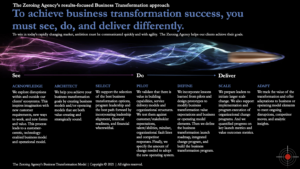The Point: Business Transformations demand an intense focus on short-term performance, but success needn’t come at the expense of long-term value. At Tip of the Spear Ventures, our Business Transformation consultancy — The Zeroing Agency — we see this desire for focus at times competing with successful initiatives outcomes. The question we ask most often is, “Should Short-term achievements compromise the Long-term success of overall Business Transformation?” So, in this post we’ll explore the importance of keeping a long-term view during business transformation… Enjoy!
Attend Webinars & Workshops – View our upcoming Webinars & Workshops
Business Transformation Long-term View
Anyone who has been through a business transformation knows that leadership requires a keen focus on the immediate results. Some moves are obvious. For example, incorporating value-creation metrics in a long-term vision, and using aggressive cash-management techniques, can help fund restructuring while avoiding existential crisis down the line.
Some moves are more risky. Leaders can be tempted to make rash decisions that could lead to irreversible financial ruin or worsening of their company’s long-term health. There are many examples of companies that have survived financial crises by cutting off discretionary spending only to lose their business later on when they were unable to rely on new investments or become unreliable. These cases can cause more damage than the initial financial loss. The loss of capital investment, whether in growth, innovation or maintenance, can lead to a host of other problems. Each one is small and easily corrected, but all add up to create a unreliable operation that damages the customer and the business’ reputation.
Leaders who balance the short-term and long-term in business decisions are what make Business Transformations successful. Many investments that don’t pay off in a timely manner (in less than two year) are still valuable and important to the viability and well-being of the company. Although there are not always clear answers to these investment decisions, we have found that there are a few methods that can help you make the right decisions with the information available.
Looking to Transform Your Business?
Download Your 37 page | 128 question Business Transformation Self-Assessment Workbook!
Is Business Transformation a Binary Decision?
Many companies respond to financial difficulties by freezing all spending. This includes capital expenditure, hiring, travel and any other discretionary costs. These moves are sometimes necessary during times of financial distress. It’s best to be more careful in most cases.
Managers should discuss the company’s largest investments in detail, paying attention to both short-term as well as long-term consequences of delaying investment. It can be disastrous to let such decisions fall within a broad spending policy. A global manufacturing company that relied heavily on electrical power decided to defer a planned transformer rebuild for a year in order to save money. Five months later, the transformer exploded, causing 20 percent of production to be stopped. The company then built and installed a new replacement. A transportation company delayed replacing key logistical equipment, which caused collateral damage to its equipment and plant.
It is better to divide spending into smaller categories that can be better discussed and understood for the long-term impact on health. It is important to distinguish between repainting hallways and repairing an electrical transformer. This distinction is not recognized by a general ban on spending maintenance money. Similar to a hiring freeze for executive assistants, it presents different risks than a freeze on vehicle drivers or sales managers.
One business transformation saw executives from a consumer-products firm discover that plant managers had not been disciplined in their spending. They invested in projects without taking into account hurdle rates and returns. More than 350 projects would be affected if a spending freeze was implemented. Executives worked with plant managers during the Business Transformation process to determine the best compromise between the need to deliver products and serve customers. They also discussed the possibility of delaying certain projects to save costs. They found that almost half of the projects they had planned could be delayed. The team implemented a program for working capital management to make inventory management easier. They approved spending that would allow the company to grow in the short and long term, while also instituting strict internal controls in areas such as overtime travel and maintenance.
Business Transformation Investment Orientation
Under pressure, managers in Business Transformation situations are often unable to take the time to carefully evaluate which activities and investments they should support or cut. Decisions are often made based on who has the greatest organizational influence, is the most persuasive, or has the highest level of personality to protect his programs and people. This is a common but not very effective way to make cuts.
We have seen companies use a better approach: a list of all actions that could create near-term cash. This list is ranked according to how much damage each could do to the long term health of the company. Typically, this will prioritize actions with the highest net current value (NPV). This list should be discussed early in the Business Transformation process. It must evaluate the impact of selling all assets and activities, as well as whether they are being discontinued or divested. The list will be completed when all actions have been taken. Although it is a difficult exercise, it allows for all ideas to be discussed.
This list includes actions that are immediate and pose little risk. Actions that have a negative impact on long-term growth prospects and operational reliability will be lower down. It is important to distinguish between real and perceived long-term risks of damage. It is possible to do this by spending the time to fully understand each investment and making sure that someone is given the hard questions.
It is also a good idea for companies to set quantifiable metrics that will trigger the next cut if they are unable to pay their bills within a specified time period. It creates a plan of action for if things go wrong. It is also important to have a clear understanding about the future risks that could affect the stability of the business.
You, the Business Transformation Leader, might be able to find other actions that you could take. You may have less long-term impact than eliminating one project over another. This could make you feel more comfortable about approving one alternative versus another. You could also use Business Transformation as an exercise to reduce the time between spending approvals so that you approve only the minimum spending. You would be able to keep control of your future financial investments, in the event that things change or you have to take more drastic measures.
Discourage Short-term Actions with Negative Long-term Consequences
Increased accountability and pressure on business unit managers to meet their numbers can lead to short-termism, which often leads to poor business decisions. There are many ways they can cheat, and they may be attracted to it. Some tactics can be purely financial, like allowing sales discounts in order to reach near-term volume goals and margin goals. Others may involve structuring risky or back-loaded contracts. Some tactics can be more risky, like allowing lower quality products to go on the market, delaying maintenance outages until the next accounting period or continuing production despite safety and reliability concerns. For example, a manager in a global commodities firm hoped to increase production by delaying routine maintenance on heavy equipment, despite engineering concerns. Shortly after the equipment broke down, a long production outage ensued. It is important to note the tension between innovation and execution. In an environment that values every dollar, innovation requires experimentation and failure. It can be difficult to defend this kind of innovation.
It is important to establish urgency and accountability for short-term performance targets, without encouraging shortcuts that may be costly and have unavoidable negative consequences. Companies deal with this by protecting employees and budgets for strategic innovation while simultaneously reducing costs in other areas. Others establish short-term goals and outline what managers can do to achieve them. It is important to clearly identify and understand the effects of each step in the company’s ability create value.
Invest in Your People
Our experience shows that the most important attribute of a successful business transformation and a healthy company are the people who run it. In many cases, however, investing in people is the best way to invest in a company when it’s struggling. These steps can be used to quickly save money, whether it is pay freezes, cuts, elimination of training and benefits, or even the elimination of team-building activities. We know of more than one company that drastically reduced the hiring of leadership talent at entry level during the 2009 recession. It now faces a shortage of leaders at the middle level of the organization.
We believe that nearly all of these actions will have a negative impact on a company’s long term health. Companies depend on their employees more when a company is in trouble than they do when it is healthy. This includes the ability to increase productivity, bring up creative ideas, support morality, and improve teamwork. This will send a message to employees that they are valued and will encourage them to participate in the Business Transformation. While it is essential to make individual decisions about talent, it should also be possible to avoid cutting across-the-board benefits and people spending.
Leaders must be encouraged and supported to take hard decisions that will benefit the long-term, even if they may not yield immediate results. This starts with an aggressive education-and-awareness campaign that provides the entire organization with the tools to understand what value creation means and how it is measured. Training can be provided on financial statements, how to interpret them, how to calculate the NPV, return of invested capital, as well as how to make economic profit. Performance evaluation should be tied to short-term results. Compensation should link in some ways with equity to reflect long-term value, especially for senior leaders. Senior leaders should also be consistent in communicating the story.
SUMMARY
It is difficult to implement rapid business transformation in the most challenging of circumstances. Even if a company achieves short-term success, creating long-term value is a higher priority. Leaders who are able to transform a company should have a vision and a roadmap with markers established. They must also guide their teams in managing within this vision.
Sam Palazzolo





